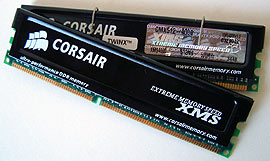Corsair TwinX1024-4000 DDR Memory Review
When Intel
released the popular i865PE/i875P chipsets along side the 800 MHz FSB Pentium4 processor, the game changed
forever. Before this precipitous event, enthusiasts could never
have thought about about sacrificing a memory module's latency for more bandwidth, but
these days P4 "C" users running 300+ MHz FSB, bandwidth is king.
Any
experienced geek should be familiar with the name Corsair, after all they've
been producing memory
geared at the cream of the crop
since 1994. With competition heating up between manufacturers and their PC3700/4000 memory modules,
Corsair have released the XMS4000 dual channel DDR series
lest they risk falling behind in the eyes of consumers.
Today we're
going to be looking at the flagship Corsair TwinX1024-4000 memory.
These twin DDR modules are rated to run at an amazing 250
MHz FSB, however that is with latency set at the rather lax JEDEC
PC3200 standard timings of 3-4-4-8. To achieve this speed the voltage supplied
to the memory must also be increased to 2.75V.
We're not surprised much by the increase from a default voltage from
2.6V to 2.75V; a move probably necessary to increase manufacturing yields and improve
stability of the memory modules. Most other memory manufacturers are doing
the same thing, so it really shouldn't be an issue with JEDEC
purists. ;)
Under the Armor:
When we removed the black aluminum heat spreader on
one of the 512MB TwinX-4000 DIMMs we were greeted with 16x 256Mb Hynix DRAM,
specifically HY5DU56822BT-D43. According to Hynix, these DRAMs are officially rated to run at 200
MHz with timings of 3-3-3-8 and a
default voltage of 2.5V.
 I know some of you out there might wonder why
Corsair are selling 'pre-overclocked' memory but does it really matter if the XMS4000
runs at the rated speed?
I know some of you out there might wonder why
Corsair are selling 'pre-overclocked' memory but does it really matter if the XMS4000
runs at the rated speed?
We first
installed the XMS4000 memory into an AMD test system
and changed the memory timings to the most aggressive in the BIOS.
Unfortunately, we were met with some difficulty as the memory would not run at 200
MHz FSB with 2-2-2-5 timings. After playing around with the timings, and setting the
memory voltage to 2.77V we were able to run the memory at 2-3-3-6, at 200 MHz FSB
which was not very encouraging.
Slowly we started to raise the FSB and at around 215 MHz
we ran into a few stability problems but increasing the memory voltage to 2.9V solved
that quickly. In the end we were able to hit a maximum speed of 223 MHz FSB on
our Epox 8RGA+ test motherboard. Raising the timings to 3-4-4-8 did not help us
overclock even 1 MHz higher.
On the Intel side of things, we plugged the memory
into an Abit IS7-G test system and started to tinker with the timings. As with
the AMD test system, even at 200 MHz FSB we were not able to run the Corsair
TwinX-4000 memory at 2-2-2-5, in fact we could only run 3-4-4-8!
Using a P4 2.4C
processor I immediately raised the FSB to 250 MHz and to my surprise everything
worked just fine! Feeling lucky I went up a bit higher on the FSB, but ran into
stability problems. Raising the memory voltage to 2.8V solved everything and
with the Intel test system we were able to hit a nice 258 MHz FSB!
It looks like these days more and more memory modules
are tuned to run on Intel systems.

